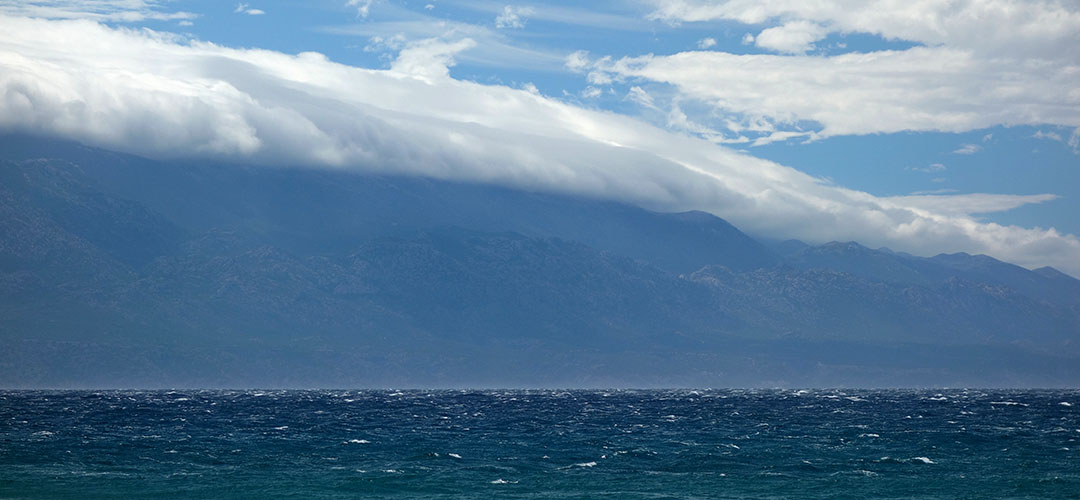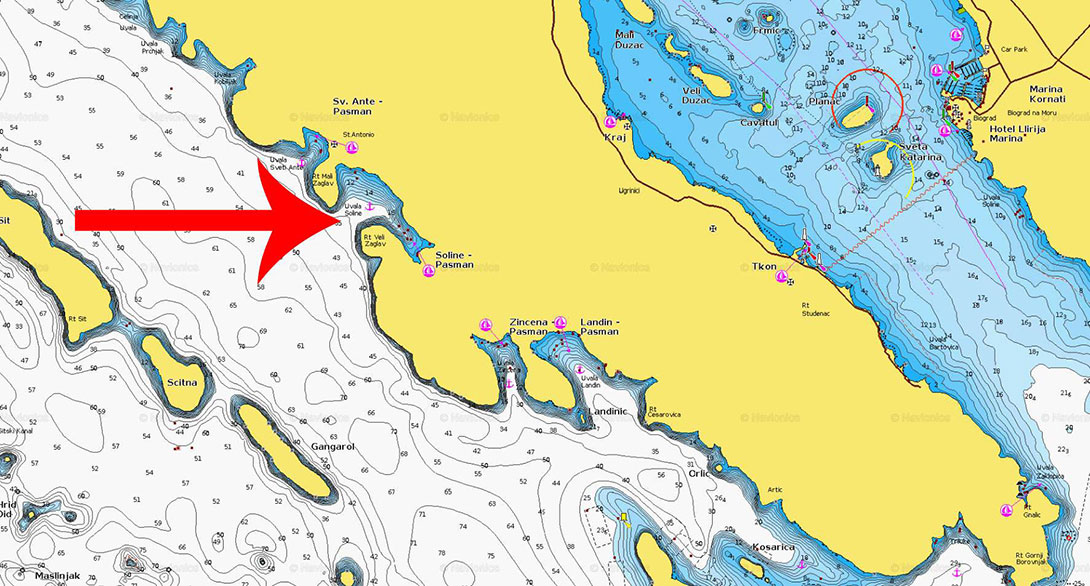Safe mooring spots in Croatia for Strong Winds like BURA - Zadar archipelago
Safe Mooring Spots in Croatia During the Bura Wind - Navigating the Zadar Archipelago:
The Bura wind, often described as the Adriatic's most unpredictable and dangerous wind force, requires sailors to be constantly cautious and alert. Let's delve into Bura, understand its signs early, and most importantly, know where to find safe mooring spots if we are caught in its path. This proactive approach will empower us to navigate the Bura wind with confidence and control. But first, here's some background information on Bura, the Wind:
When does the Bura wind blow?
It happens when air attempts to escape from a higher-pressure area to a lower-pressure area. The strength of the Bura wind increases with the difference in air pressure between low and high pressure areas. Natural barriers like the Velebit mountains and valleys can influence the strength of this wind. When these barriers extend to the sea, they can affect the wind's intensity similarly to how a slope does.
Bura is undoubtedly the most dangerous wind for sailing in Croatia, particularly for novice sailors. Bura blows from the NNE, NE, or ENE (north-northeast, northeast, and east-northeast) directions. It may be a very windy, dry, and chilly wind blowing from land to sea at up to 55 knots. Even experienced sailors and professional skippers find it unenjoyable on sailing boats.
Can you predict the Bura Wind?
Of course you can! The first indicators of the Bura are a substantial improvement in visibility on the Adriatic and the formation of source clouds, or cloud towers in the sky, on the mountain of Velebit, as well as thin white clouds (caps) over the tops of coastal mountains.
When the air pressure decreases quickly, this indicates an oncoming Bura. Within six to 12 hours, meteorologists predict a pressure drop of five to ten hPa. The air pressure increases by two to three hPa after that, and the weather clears up from the north. Simultaneously, the temperature plummets.
While meteorological forecasts indicate Bura's presence, she has been known to start and show up unexpectedly due to novice skippers failing to recognize her. Suppose you're at sea and see thin white clouds forming above the summits of coastal mountains. In that case, you should head for protected bays in Croatia immediately.
Remember, it's your responsibility to check the Croatian Meteorological and Hydrological Service (DHMZ) for real-time updates before sailing. This caution will ensure we are well-prepared for any unexpected changes in weather conditions.

Finding Safe Mooring Spots in Croatia During Bura
When sailing during Bura, locating safe mooring spots in Croatia that provide the best protection from unpredictable gusts is crucial. This will ensure you feel reassured and secure during your journey.
While Bura's strength isn't always an issue, adjusting to the gusts' rapidly shifting direction and unpredictability will be tough. Unless you are an experienced sailor looking for a challenge, Bura is no pleasure to sail in - and even the wise wouldn't venture out if Bura is approaching 35 mph. With those unexpected wind gusts, it's just not pleasant. Bura happens suddenly and without notice in high winds.
It's crucial to be aware that local topography can unpredictably amplify wind speeds. This knowledge will keep us informed and prepared for the potential challenges of sailing in Bura.
They reach wind speeds of 5 to 7 Beaufort and, in gusts, much higher. The top speed is more than 200 km/h. The short, steep waves, which do not even turn out to be exceptionally high, with a wave height of 1 to 2.5 meters, are unappealing to all skippers at Bura.

*A hint: Speeds of 304 km/h were reported on the highway route in 2003. Source: Wikipedia
March and the Mighty Bura: Three Blows Before Spring In Croatia
Iit is said that if Bura blows three times in March, the Summer will be steady and hot. This local saying is folklore rather than a scientifically proven prediction. The belief that Bura blows three times in March is a well-known piece of local folklore along the Adriatic coast and parts of the Balkans.
This saying suggests that the cold, strong Bora wind will strike three times before spring fully arrives, reflecting traditional weather wisdom based on generations of observation. While not scientifically exact, the Bora is known for its episodic nature, often occurring multiple times a month, especially during the transitional period of March.
March is a transitional month, and intense Bora episodes still happen as winter air masses interact with warming spring weather. 2021, for example, Bura blew more than three times in March, but we have to start counting at night at the end of February at 27. & 28. 02., then the daily ones: 06.03, 10.03., the powerful ones 18.-23.03., and then 03. & 04. 04. The myth about the hot and stable weather was accurate, even if the sweltering summer days and nights began later than usual (just by the end of June) ... The Summer (2021), we had 6 heat waves in Croatia!
Bura usually lasts three days, and then on the last day around 12:00 -13:00 hours, the Bura Wind changes into the west wind Mistral or northwestern wind Tramontana, which is more stable and fun to sail and enjoy, but it will usually stop abruptly around 17:30-18:30, so if you enjoy sailing, you should make the most of it!
Recommended Safe Mooring Spots in Croatia
Regarding the Bura, here's some sound advice: If you're sailing along the shore of an island facing the mainland and come across a zone with no vegetation, such as on the island of Pag, it's an indication that a strong Bura is blowing. As a result of the wind-blowing seawater sprays down the coast, you should anchor on the southern side of the islands, where there are more hills and vegetation. If you've been caught off guard by the Bura wind in the Zadar archipelago near our bases like Biograd Marina Šangulin or Marina Dalmacija Sukošan, we recommend sailing into Soline bay:
On the south side of Pašman island, anchoring on the left side of the bay will provide you better protection given the directions where Bura comes from. Links here:

Garbage collection is included in the fee if you bring your buoy there, which is a good value. There are also a few eateries where you should feel secure till the Wind passes. The restaurants are both quite excellent; one is basic, with just two menu options: fish or meat, but it's still nice...the other has a more extensive menu.
Garbage collection is included in the fee if you bring your buoy there, which is a good value. There are also a few eateries where you should feel secure till the wind passes. The restaurants are both quite excellent:
- Konoba Soline - A cosy yet straightforward place offering two main options: fish or meat, with fresh local ingredients.
- Restaurant Zrinski - A more extensive menu featuring traditional Croatian dishes and seafood specialities.
(Disclaimer: These recommendations are based on firsthand experience and sailor feedback; we are not affiliated with these businesses.)
Best Safe Mooring Spots in Croatia During Bura
If you're sailing in the Zadar Archipelago and get caught in a Bura storm, your best bet is to find shelter in one of the well-protected bays.
Here is the RECAP of the top recommendations:
- Soline Bay (Pašman Island) - A Safe Refuge from Bura
📍 Location: South side of Pašman Island

✅ Best Protection: Excellent shelter from NNE, NE, and ENE winds
✅ Mooring Options: Anchoring on the left side of the bay for maximum protection
✅ Facilities: Restaurants, garbage collection included in mooring fee
Soline Bay is one of the most protected bays in Croatia, offering excellent coverage from Bura's strongest gusts. Due to its southern position on Pašman Island, the high terrain acts as a natural barrier, reducing wind intensity.
⚠️ Tip: Stay on the left side of the bay for better wind protection.
Aside from its safety, Soline Bay offers some great dining options while you wait for calmer weather. One restaurant keeps it simple with only two menu options: fresh fish or meat. At the same time, the other offers a more extensive selection. Either way, you'll have a secure and relaxing stopover until the winds subside.
🔗 Mooring Info & Location:
2. Sali Bay (Dugi Otok) – A Well-Protected Marina

📍 Location: Southeastern coast of Dugi Otok
✅ Best Protection: Strong wind cover from Bura
✅ Mooring Options: Secure marina and anchoring options
✅ Facilities: Fuel station, restaurants, grocery stores
Sali Bay is a well-known safe mooring spot in Croatia, offering strong protection from northern and northeastern winds. The marina provides secure berths and plenty of amenities to make your stay comfortable. This is an ideal stopover if you need to refuel, stock up on supplies, or relax.
3. Marina Preko (Ugljan Island) – A Sheltered Stop Close to Zadar

📍 Location: Eastern Ugljan Island, across from Zadar
✅ Best Protection: Shielded from strong northern gusts
✅ Mooring Options: Marina with berths and anchoring options
✅ Facilities: Water, electricity, restaurants, and ferry access to Zadar
If you're near Zadar and looking for a safe harbour, Marina Preko is one of the most protected bays in Croatia. Located on Ugljan Island, it provides substantial shelter from Bura winds and excellent marina services for refuelling and restocking supplies. The Marina in Preko is well-protected from Bura wind thanks to its breakwater, which reduces wind impact, minimizes waves, and ensures safer mooring. This makes it a reliable refuge for sailors in the Zadar Archipelago during strong winds.
Emergency Backup Plan: What If Marinas Are Full?
- ✔ Drop anchor near islands with natural wind barriers.
- ✔ Use an extra anchor chain to prevent drifting.
- ✔ Avoid exposed coastlines where waves intensify.
- ✔ Seek emergency docking at lesser-known harbours.
🚢 Final Advice: Bura can be unforgiving no matter how skilled you are. When in doubt, stay at the marina; it's always better to wait than risk getting caught in dangerous conditions. By planning ahead and choosing the right protected bays in Croatia, you'll enjoy a safe, smooth, and unforgettable sailing experience.
But, GUYS AND GIRLS, our first and primary piece of advice is this: no matter how skilled a sailor or skipper you are, or at least believe you are, When Bura smacks you in the face, REMAIN AT THE MARINA!!!
Ready to Set Sail? Stay Safe & Enjoy Croatia's Stunning Coastline! Would you like additional recommendations for safe mooring spots in Croatia? Feel free to reach out, and happy sailing! ⛵🌊
Bura Wind FAQs: 3 Most Common Questions & Surprising Facts
FAQ About Bura Wind
The Bura (Bora) wind in Croatia is a strong, dry, and cold northeasterly wind that blows from the Dinaric Alps toward the Adriatic Sea. It is known for its sudden gusts, which can reach hurricane-force speeds, and its ability to create clear but extremely cold weather.
Key Characteristics of the Bura Wind
Origin:
- The Bura forms when cold continental air masses from Central Europe rapidly descend over the Dinaric Alps, rushing toward the Adriatic Sea.
- The contrast between cold air over the mountains and warmer sea air generates intense wind speeds.
Speed & Intensity:
- Wind speeds often exceed 200 km/h (125 mph), particularly near Velebit Mountain.
- The strongest recorded gust was 248 km/h (154 mph) on the Maslenica Bridge (Croatian Meteorological Institute, 2022).
- This makes the Bura comparable to a Category 3 hurricane, which starts at 178 km/h (111 mph).
Effects:
- Dangerous for sailing and road traffic, often closing highways (e.g., A1 near Sveti Rok Tunnel).
- Dries out vegetation due to low humidity.
- Creates the “sea smoke” effect, where cold air lifts warm seawater vapor, forming a misty appearance.
- Clears the atmosphere, leading to crisp, blue skies after storms.
Most Affected Areas:
- Northern Adriatic: Trieste (Italy), Rijeka, Senj, Karlobag
- Central Dalmatia: Zadar, Split, Makarska
- Southern Dalmatia: Dubrovnik (weaker winds here)
The Bura is famous for drying Pag cheese and Dalmatian prosciutto, giving them their distinct flavors. Though feared by sailors, locals appreciate the fresh, crisp air it brings after storms.




